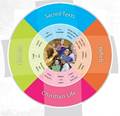The Vision for Religious Education as stated in the Religious Education Curriculum of Brisbane Catholic Education gives voice to our hopes for our students in terms of their religious literacy and faith formation.
“The schools and colleges of the Archdiocese of Brisbane aspire to educate and form students who are challenged to live the gospel of Jesus Christ and who are literate in the Catholic and broader Christian tradition so that they might participate critically and authentically in faith contexts and wider society”
Religious Education consists of two distinct but complementary dimensions, namely an educational dimension and a faith formation dimension.
The first dimension, most commonly referred to as the classroom teaching and learning of religion, is focused on Religious Education as an educational activity. It utilises a range of teaching and learning processes and resources.
The second dimension, faith formation, is reflected in the religious life of the school, family and parish. The educational dimension and the faith formation dimension are inextricably linked. The classroom teaching of religion is one element in a complex web of experiences that have the potential to nurture the faith life of young people.
All classroom teachers are working from the Brisbane Catholic Education Religious Education Syllabus and Curriculum documents. Religious Education aims to "develop students' religious literacy in the light of the Catholic tradition, so that they may participate critically and effectively in the light of their faith communities and wider society" (A Syllabus for Religious Education for Catholic Schools).

The curriculum involves four strands: These strands are interrelated and are taught in an integrated approach that is appropriate to the learning contexts of the class.
1. Sacred Texts
2. Beliefs
3. Church
4. Christian Life
© Brisbane Catholic Education, All Saints (2023)